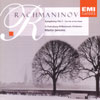Rachmaninov Symphony No 1; Isle of the Dead.
View record and artist detailsRecord and Artist Details
Composer or Director: Sergey Rachmaninov
Label: EMI
Magazine Review Date: 4/1999
Media Format: CD or Download
Media Runtime: 66
Mastering:
Stereo
DDD
Catalogue Number: 556754-2

Tracks:
| Composition | Artist Credit |
|---|---|
| Symphony No. 1 |
Sergey Rachmaninov, Composer
Mariss Jansons, Conductor Sergey Rachmaninov, Composer St Petersburg Philharmonic Orchestra |
| (The) Isle of the dead |
Sergey Rachmaninov, Composer
Mariss Jansons, Conductor Sergey Rachmaninov, Composer St Petersburg Philharmonic Orchestra |
Author: John Steane
This St Petersburg Philharmonic Hall production lacks bloom and tonal vibrancy. While the balance is an often compelling realization of Rachmaninov at his darkest, and the generally darker hues and heft (upper strings in lower regions, and especially solid basses) of the Russian orchestra, problems occur – which they didn’t in this hall in either the Rachmaninov Third Symphony from this team (12/93 – with a different engineer) or, more recently, Gergiev’s spectacularly vibrant Stravinsky Firebird (Philips, 7/98) – mainly at the loudest end of the dynamic spectrum where proceedings can lapse into a drum-dominated, drill-hall flatness. The opening of the symphony’s finale is a worrying example, with tonally and positionally indistinct strings and woodwind in an otherwise unpopulated area centre-to-left, and the hardly more brilliant brass and percussion all bunched on the far right; quite a contrast with the 1966 Svetlanov or 1982 Ashkenazy where there is a more varied and even distribution of instruments across the stage and an appreciation of their brighter tonal contributions to this festive scene. The fact that Jansons divides his violin sections to his left and right may, in the above example, have contributed to the problem – as they are unable to provide a united front against the brass and percussion – and it must be admitted that, below extreme fortissimos, the balance is satisfyingly laid out and naturally revealing (indeed, as reactions to recorded sound are both personal and system-dependent, you may not share my reservations).
Jansons, like Svetlanov, takes a freer hand with the symphony than Ashkenazy; the opening strings’ unisons forcefully, broadly and fatefully given, as is the custom with the similar opening of Borodin’s Second Symphony; yet, unlike Svetlanov, Jansons refers back to this broad presentation of the theme, from 8'16'', as an effective launch-pad for the recapitulation. Nuances of tempo and dynamics also – very expressively – suggest a fear of entering initially into the fray of the outer Allegros, and contrasting sections are either considerably slower or more varied. You may feel, as the symphony is so tightly knit thematically, that it benefits from a greater control of overall tempo – a view superbly espoused by Ashkenazy. Yet there is room for a modern account of a more volatile, uninhibitedly splenetic all-Russian approach (even if we might have been spared Jansons’s unidiomatic timpani additions); Svetlanov’s recording, though a good one for the period, understandably breaks up as his finale’s dance reels frenziedly into catastrophe (orchestral delirium of a kind we shall probably never experience again); his slow movement is too slow for those alternately caressing and anxious Janacek-like ostinatos to make their effect, and Jansons’s players are generally much more careful about correct pitching. Russian orchestras are also arguably better equipped – instrumentally and temperamentally – to realize the score’s ‘gipsy’ colours and contours (courtesy of Balakirev, and central to the symphony’s subtext), and the intense gloom and eventual desperate intensity of The isle of the dead.
So, a cautious welcome for this completion of Jansons’s Rachmaninov symphony cycle. Perhaps the best advice would be to wait for Pletnev to complete his. '
Jansons, like Svetlanov, takes a freer hand with the symphony than Ashkenazy; the opening strings’ unisons forcefully, broadly and fatefully given, as is the custom with the similar opening of Borodin’s Second Symphony; yet, unlike Svetlanov, Jansons refers back to this broad presentation of the theme, from 8'16'', as an effective launch-pad for the recapitulation. Nuances of tempo and dynamics also – very expressively – suggest a fear of entering initially into the fray of the outer Allegros, and contrasting sections are either considerably slower or more varied. You may feel, as the symphony is so tightly knit thematically, that it benefits from a greater control of overall tempo – a view superbly espoused by Ashkenazy. Yet there is room for a modern account of a more volatile, uninhibitedly splenetic all-Russian approach (even if we might have been spared Jansons’s unidiomatic timpani additions); Svetlanov’s recording, though a good one for the period, understandably breaks up as his finale’s dance reels frenziedly into catastrophe (orchestral delirium of a kind we shall probably never experience again); his slow movement is too slow for those alternately caressing and anxious Janacek-like ostinatos to make their effect, and Jansons’s players are generally much more careful about correct pitching. Russian orchestras are also arguably better equipped – instrumentally and temperamentally – to realize the score’s ‘gipsy’ colours and contours (courtesy of Balakirev, and central to the symphony’s subtext), and the intense gloom and eventual desperate intensity of The isle of the dead.
So, a cautious welcome for this completion of Jansons’s Rachmaninov symphony cycle. Perhaps the best advice would be to wait for Pletnev to complete his. '
Discover the world's largest classical music catalogue with Presto Music.

Gramophone Digital Club
- Digital Edition
- Digital Archive
- Reviews Database
- Full website access
From £8.75 / month
Subscribe
Gramophone Full Club
- Print Edition
- Digital Edition
- Digital Archive
- Reviews Database
- Full website access
From £11.00 / month
Subscribe
If you are a library, university or other organisation that would be interested in an institutional subscription to Gramophone please click here for further information.




